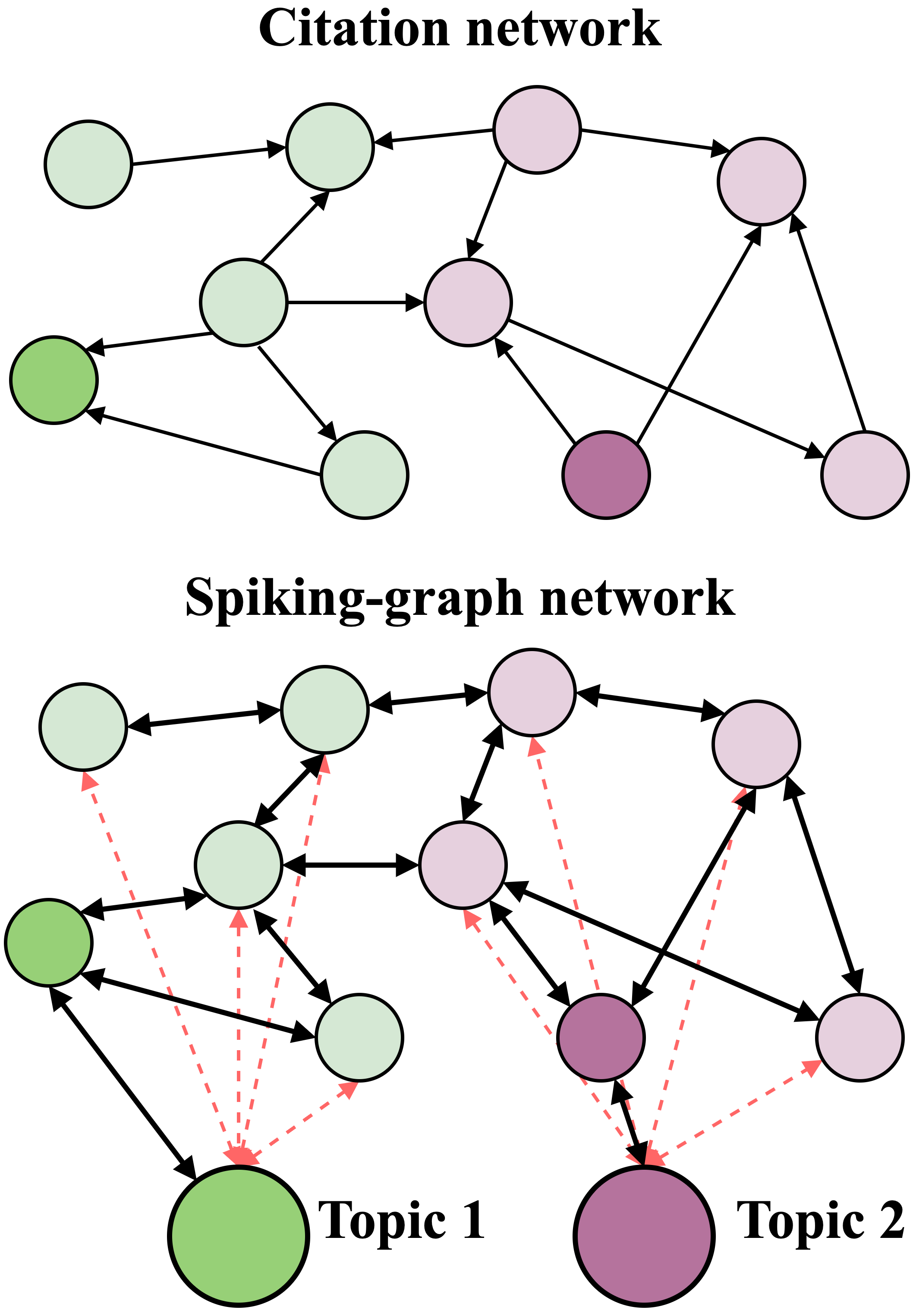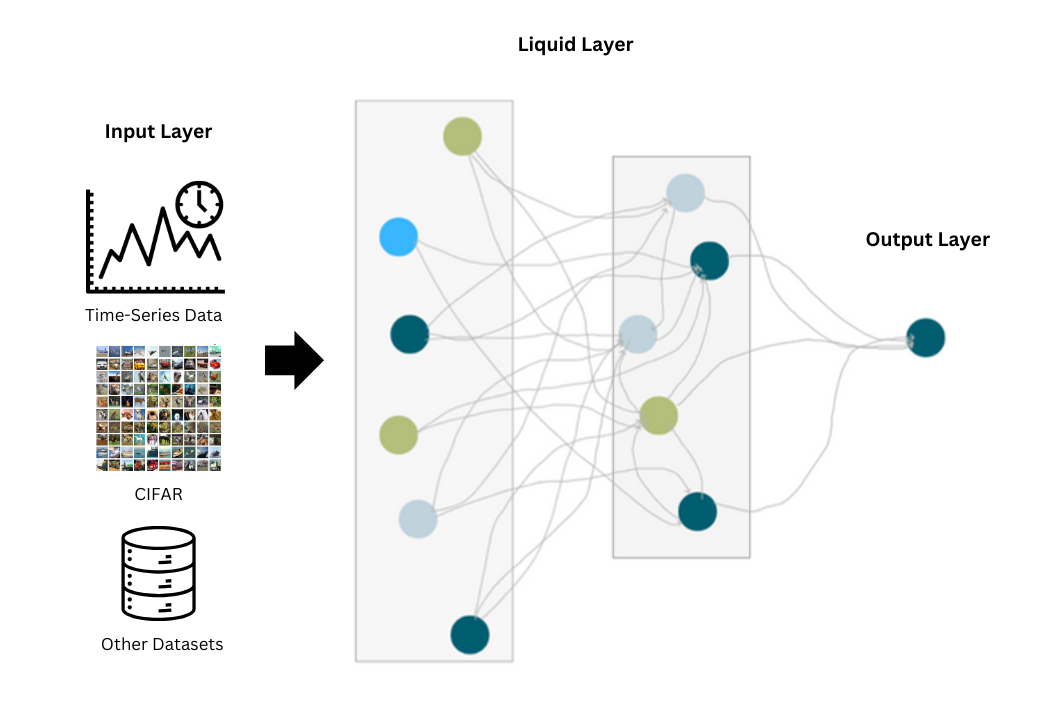Transductive Spiking Graph Neural Networks for Loihi

0

Sign in to get full access
Overview
- This paper introduces Transductive Spiking Graph Neural Networks (TSGNNs), a novel approach for applying spiking neural networks to graph-structured data.
- The TSGNNs are designed to run on the Loihi neuromorphic chip, enabling efficient and low-power graph processing.
- The model is evaluated on several benchmark graph datasets and demonstrates state-of-the-art performance compared to traditional graph neural networks.
Plain English Explanation
The paper presents a new type of neural network called Transductive Spiking Graph Neural Networks (TSGNNs) that is designed to work with graph-structured data. Graphs are a way of representing relationships between different things, like how people are connected in a social network.
The key innovation of TSGNNs is that they use spiking neurons, which are inspired by how real neurons in the brain work. These spiking neurons can process information more efficiently and with less power than traditional artificial neurons. The TSGNNs are also designed to run on a specialized computer chip called Loihi, which is optimized for this type of spiking neural network.
The researchers tested the TSGNNs on several standard graph datasets and found that they outperformed other types of graph neural networks in terms of accuracy. This suggests that the spiking approach and the Loihi chip can be very effective for working with graph-structured data, which has many applications in fields like social network analysis, recommendation systems, and transportation planning.
Technical Explanation
The paper introduces Transductive Spiking Graph Neural Networks (TSGNNs), a novel architecture that combines spiking neural networks with graph neural networks to enable efficient and low-power processing of graph-structured data on the Loihi neuromorphic chip.
The key components of the TSGNN architecture include:
- A spiking graph neural network layer that propagates spike signals through the graph structure
- A transductive learning approach that allows the model to make predictions on both labeled and unlabeled nodes
- Specialized Loihi-compatible neuron and synapse models that enable low-latency, event-driven processing
The researchers evaluate the TSGNNs on several benchmark graph datasets, including node classification and link prediction tasks. The results show that the TSGNN model outperforms traditional graph neural networks in terms of accuracy, while also demonstrating low power consumption and low latency due to the spiking and neuromorphic architecture.
The SIGNN and Spike-Driven Transformer models are related approaches that also leverage spiking neural networks for graph and sequence processing, respectively.
Critical Analysis
The paper presents a well-designed and thorough evaluation of the TSGNN model, demonstrating its effectiveness on a range of graph tasks. However, there are a few potential limitations and areas for further research:
- The paper does not provide much insight into the interpretability or explainability of the TSGNN model, which is an important consideration for many real-world applications.
- The evaluation is focused on relatively small-scale graph datasets, and it's unclear how the model would scale to larger, more complex graphs encountered in practice.
- The authors mention that the Loihi chip used in their experiments has limited memory and computational resources, which could constrain the size and complexity of graphs that can be effectively processed.
Further research could explore ways to improve the interpretability of TSGNNs, investigate their performance on larger-scale graph problems, and potentially investigate extensions to the model architecture or training process to overcome the resource limitations of the Loihi chip.
Conclusion
The Transductive Spiking Graph Neural Networks (TSGNNs) presented in this paper offer a promising approach for applying spiking neural networks to graph-structured data. By leveraging the efficiency and low-power characteristics of spiking neurons and the Loihi neuromorphic chip, the TSGNN model demonstrates state-of-the-art performance on several graph benchmark tasks.
This research has important implications for the development of low-power, high-performance solutions for a wide range of graph-based applications, such as social network analysis, recommendation systems, and transportation planning. The spiking and neuromorphic aspects of the TSGNN model also contribute to the broader efforts to create more brain-inspired AI systems that can operate efficiently on edge devices and in resource-constrained environments.
This summary was produced with help from an AI and may contain inaccuracies - check out the links to read the original source documents!
Related Papers


0
Transductive Spiking Graph Neural Networks for Loihi
Shay Snyder (George Mason University), Victoria Clerico (George Mason University), Guojing Cong (Oak Ridge National Laboratory), Shruti Kulkarni (Oak Ridge National Laboratory), Catherine Schuman (University of Tennessee - Knoxville), Sumedh R. Risbud (Intel Labs), Maryam Parsa (George Mason University)
Graph neural networks have emerged as a specialized branch of deep learning, designed to address problems where pairwise relations between objects are crucial. Recent advancements utilize graph convolutional neural networks to extract features within graph structures. Despite promising results, these methods face challenges in real-world applications due to sparse features, resulting in inefficient resource utilization. Recent studies draw inspiration from the mammalian brain and employ spiking neural networks to model and learn graph structures. However, these approaches are limited to traditional Von Neumann-based computing systems, which still face hardware inefficiencies. In this study, we present a fully neuromorphic implementation of spiking graph neural networks designed for Loihi 2. We optimize network parameters using Lava Bayesian Optimization, a novel hyperparameter optimization system compatible with neuromorphic computing architectures. We showcase the performance benefits of combining neuromorphic Bayesian optimization with our approach for citation graph classification using fixed-precision spiking neurons. Our results demonstrate the capability of integer-precision, Loihi 2 compatible spiking neural networks in performing citation graph classification with comparable accuracy to existing floating point implementations.
Read more4/29/2024


0
Neuromorphic on-chip reservoir computing with spiking neural network architectures
Samip Karki, Diego Chavez Arana, Andrew Sornborger, Francesco Caravelli
Reservoir computing is a promising approach for harnessing the computational power of recurrent neural networks while dramatically simplifying training. This paper investigates the application of integrate-and-fire neurons within reservoir computing frameworks for two distinct tasks: capturing chaotic dynamics of the H'enon map and forecasting the Mackey-Glass time series. Integrate-and-fire neurons can be implemented in low-power neuromorphic architectures such as Intel Loihi. We explore the impact of network topologies created through random interactions on the reservoir's performance. Our study reveals task-specific variations in network effectiveness, highlighting the importance of tailored architectures for distinct computational tasks. To identify optimal network configurations, we employ a meta-learning approach combined with simulated annealing. This method efficiently explores the space of possible network structures, identifying architectures that excel in different scenarios. The resulting networks demonstrate a range of behaviors, showcasing how inherent architectural features influence task-specific capabilities. We study the reservoir computing performance using a custom integrate-and-fire code, Intel's Lava neuromorphic computing software framework, and via an on-chip implementation in Loihi. We conclude with an analysis of the energy performance of the Loihi architecture.
Read more7/31/2024


0
Exploring Liquid Neural Networks on Loihi-2
Wiktoria Agata Pawlak, Murat Isik, Dexter Le, Ismail Can Dikmen
This study investigates the realm of liquid neural networks (LNNs) and their deployment on neuromorphic hardware platforms. It provides an in-depth analysis of Liquid State Machines (LSMs) and explores the adaptation of LNN architectures to neuromorphic systems, highlighting the theoretical foundations and practical applications. We introduce a pioneering approach to image classification on the CIFAR-10 dataset by implementing Liquid Neural Networks (LNNs) on state-of-the-art neuromorphic hardware platforms. Our Loihi-2 ASIC-based architecture demonstrates exceptional performance, achieving a remarkable accuracy of 91.3% while consuming only 213 microJoules per frame. These results underscore the substantial potential of LNNs for advancing neuromorphic computing and establish a new benchmark for the field in terms of both efficiency and accuracy.
Read more7/31/2024
🧠

0
Spike-based computation using classical recurrent neural networks
Florent De Geeter (Montefiore Institute, University of Li`ege, Li`ege, Belgium), Damien Ernst (Montefiore Institute, University of Li`ege, Li`ege, Belgium, LTCI, T'el'ecom Paris, Institut Polytechnique de Paris, France), Guillaume Drion (Montefiore Institute, University of Li`ege, Li`ege, Belgium)
Spiking neural networks are a type of artificial neural networks in which communication between neurons is only made of events, also called spikes. This property allows neural networks to make asynchronous and sparse computations and therefore drastically decrease energy consumption when run on specialised hardware. However, training such networks is known to be difficult, mainly due to the non-differentiability of the spike activation, which prevents the use of classical backpropagation. This is because state-of-the-art spiking neural networks are usually derived from biologically-inspired neuron models, to which are applied machine learning methods for training. Nowadays, research about spiking neural networks focuses on the design of training algorithms whose goal is to obtain networks that compete with their non-spiking version on specific tasks. In this paper, we attempt the symmetrical approach: we modify the dynamics of a well-known, easily trainable type of recurrent neural network to make it event-based. This new RNN cell, called the Spiking Recurrent Cell, therefore communicates using events, i.e. spikes, while being completely differentiable. Vanilla backpropagation can thus be used to train any network made of such RNN cell. We show that this new network can achieve performance comparable to other types of spiking networks in the MNIST benchmark and its variants, the Fashion-MNIST and the Neuromorphic-MNIST. Moreover, we show that this new cell makes the training of deep spiking networks achievable.
Read more5/7/2024